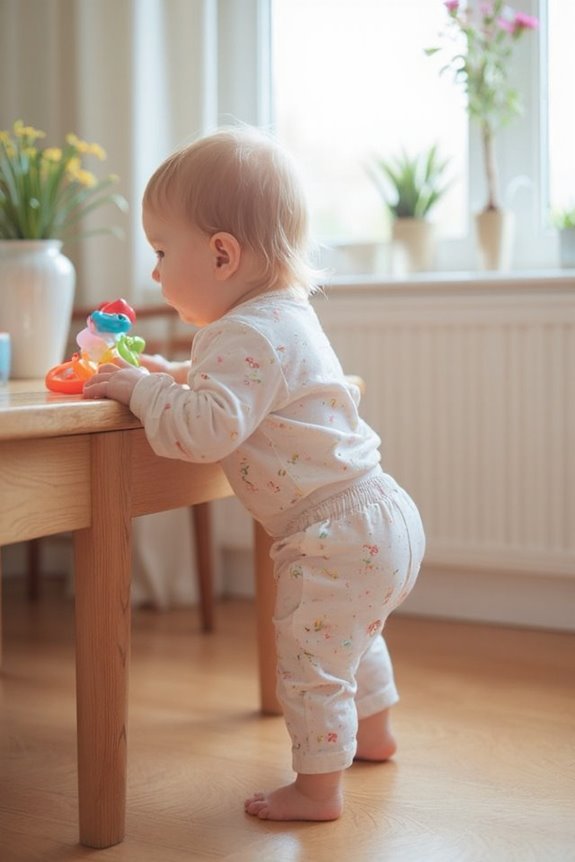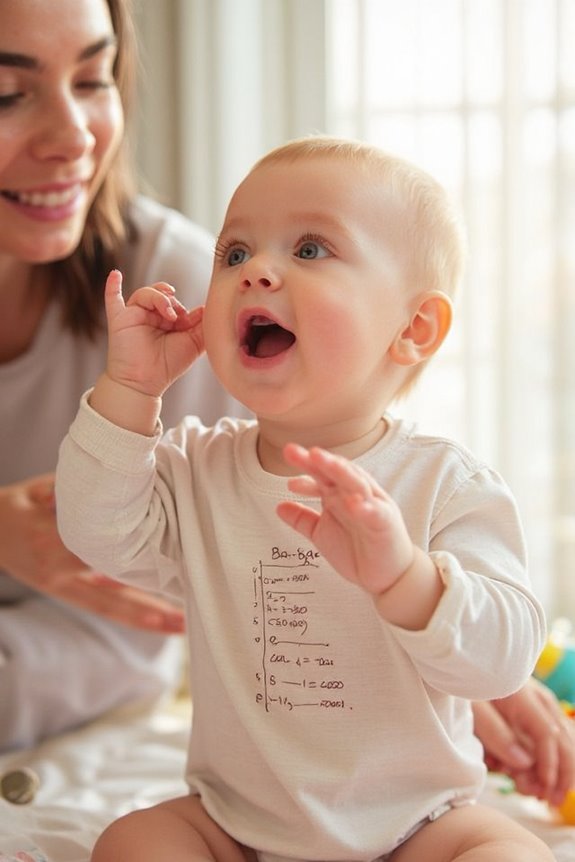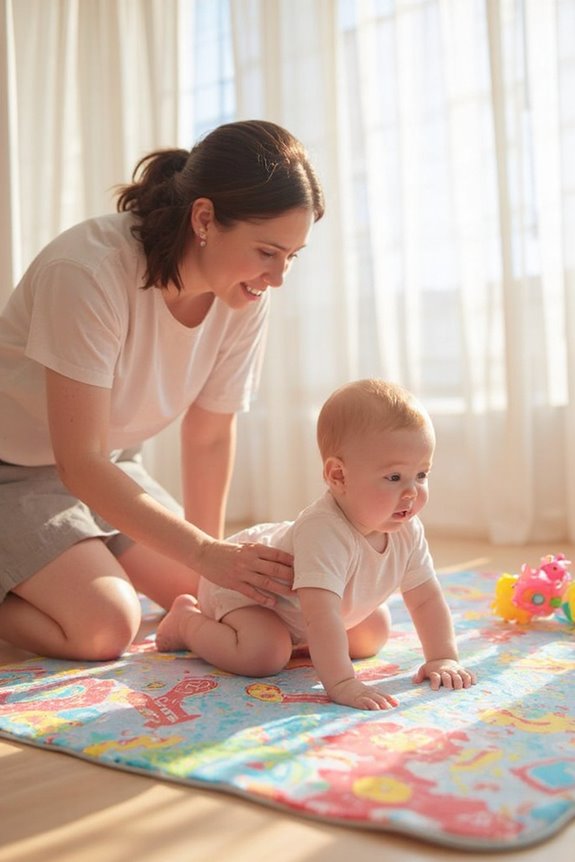Most babies start pulling to stand between 7 and 12 months, with the average being around 9-10 months. This milestone follows other developments like head control, sitting independently, and crawling. Your baby’s readiness is signaled by increased leg strength, improved core stability, and attempts to grab furniture at higher levels. Guarantee a safe environment by securing furniture and removing trip hazards. If your baby shows no interest in standing by 12 months, I’ll explain when to consult your pediatrician.
Key Takeaways
- Most babies begin pulling to stand between 7 and 12 months of age, with 9-10 months being the average.
- Pulling to stand requires prerequisite skills like head control, trunk strength, and independent sitting.
- Some early developers may start as early as 7 months, while others may wait until closer to their first birthday.
- Signs of readiness include increased leg strength, improved core stability, and attempts to grasp higher furniture.
- Consult a pediatrician if your baby shows no interest in pulling to stand by 12 months.
The Typical Age Range for Pulling to Stand
Three key phases mark a baby’s journey to standing upright. Most infants begin this developmental milestone between 7 and 12 months, with the average baby starting around 9-10 months.
Some early developers may demonstrate pulling techniques as early as 7 months, while others might not attempt until closer to their first birthday. This variability is completely normal and depends on factors like:
- Muscle strength development
- Balance and coordination
- Environmental support opportunities
When monitoring your baby’s progress, remember that standing safety is paramount. Confirm furniture used for support is stable and the surrounding area is padded. If your child hasn’t shown interest in pulling up by 12 months, I recommend consulting your pediatrician to address any potential developmental concerns.
Key Physical Milestones Before Standing
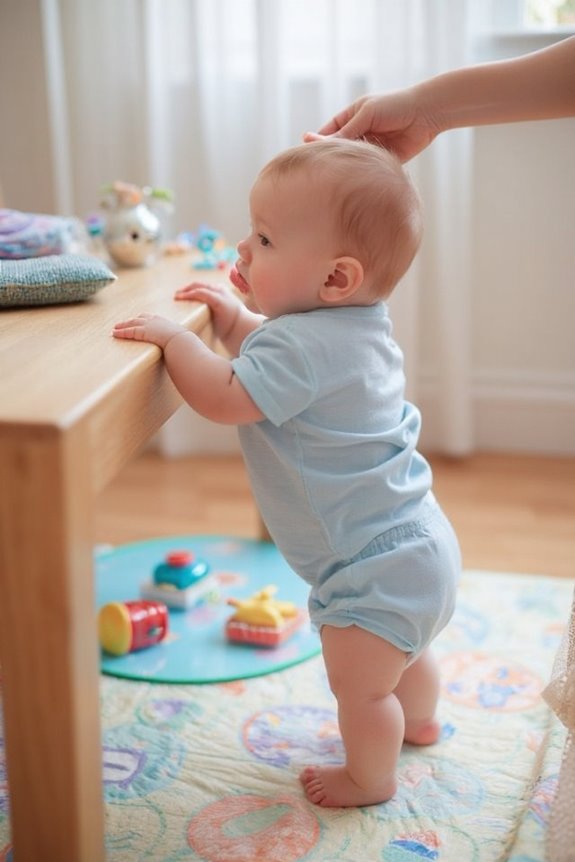
Before your baby attempts to pull up and stand, they’ll need to master several essential physical milestones that build the necessary strength and coordination. These foundational skills develop in a predictable sequence:
- Head and neck control (2-4 months): Your baby gains the ability to hold their head steady
- Trunk strength (4-6 months): Core muscles develop, supporting balance improvement
- Sitting independently (6-7 months): Establishes vital posture control
- Weight-bearing on legs (4-6 months): When held upright, babies begin testing their leg strength
Motor skill development progresses through distinct stages, including rolling, sitting, and eventually crawling (7-10 months). Each achievement builds upon previous skills, strengthening the muscles needed for standing. Tummy time from birth is particularly important for developing the back and neck muscles that enable proper balance and posture.
How Babies Learn to Pull Themselves Up
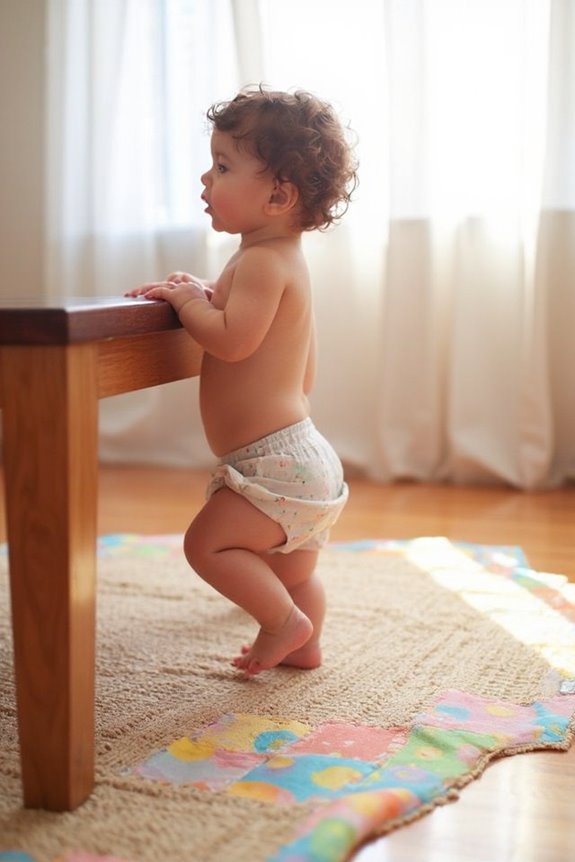
Babies discover the exciting milestone of pulling to stand through a combination of curiosity, strength development, and practice. This process typically begins around 7-8 months when they start pulling up to their knees before advancing to full standing.
The journey involves several key pulling techniques:
- Starting from sitting position
- Moving to hands and knees
- Reaching up to grab furniture
- Pulling the body upward using arm strength
- Straightening legs to achieve standing
Standing confidence develops gradually as babies:
- Master the half-kneel position (around 9-10 months)
- Practice weight shifting while holding onto support
- Learn to coordinate leg and core muscles
- Build balance through repeated attempts
- Experience the new perspective that standing provides
Most babies achieve this milestone between 9-12 months, with full mastery by 11 months.
Creating a Safe Environment for Standing Practice
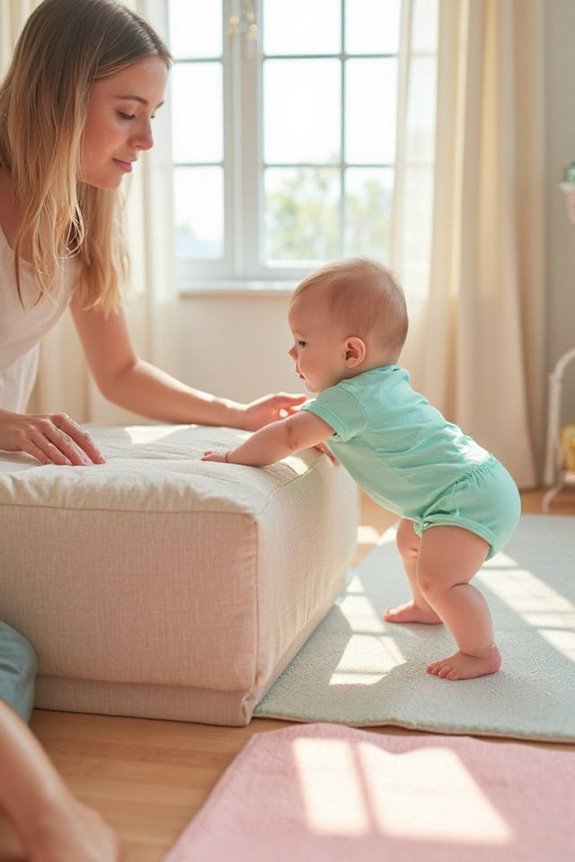
As your baby begins to experiment with pulling up and standing, you’ll need to transform your home into a safe training ground for this exciting new skill. Safety modifications are essential at this stage.
- Confirm safe flooring by using non-slip mats and removing trip hazards
- Secure supportive furniture to walls to prevent tipping
- Create clear pathways by removing obstacles
- Install protective gear like corner guards and baby gates
- Maintain supervised practice at all times
- Place soft surfaces around practice areas to cushion potential falls
- Implement gradual support reduction as skills improve
- Offer positive reinforcement when they attempt to stand
Remember to check your environment regularly for new hazards as your baby’s mobility increases. Different rooms may require different safety considerations based on their furniture and flooring.
Signs Your Baby Is Ready to Pull up
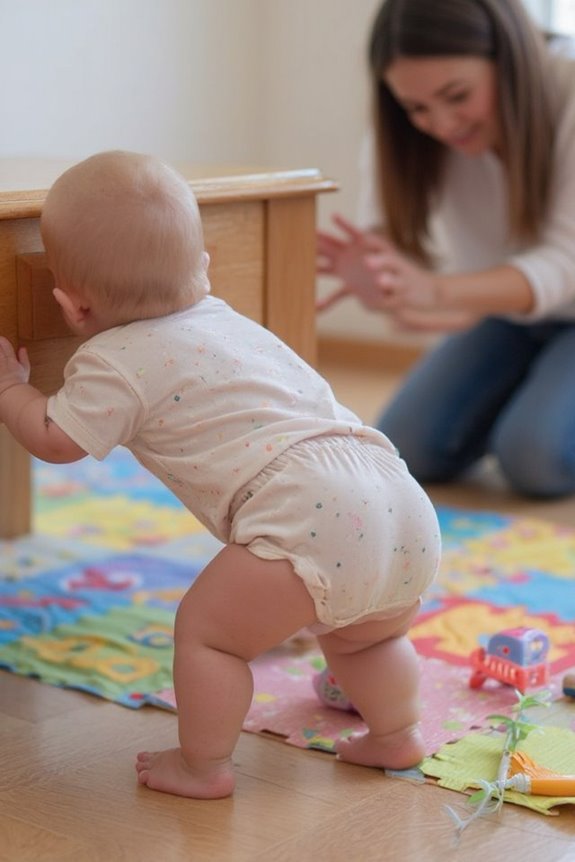
Recognizing the right moment when your little one is prepared to pull up to stand can help you provide timely support for this exciting milestone. Several physical and behavioral indicators suggest your baby is approaching this development stage.
Key signs of readiness include:
- Increased leg strength, allowing them to bear weight when supported
- Improved sitting balance and core stability
- Frequent attempts to grasp furniture at higher levels
- Strong crawling skills and ability to get into a kneeling position
You’ll also notice significant baby excitement when they successfully rise to new heights. They may squeal with delight or show determination when attempting to pull up. Their cognitive development has reached a point where they can problem-solve how to coordinate their movements to achieve this new position.
Supporting Your Baby’s Journey to Standing
When your little one shows signs of readiness to stand, you’ll want to create an environment that encourages this important milestone. Here’s how you can help:
- Place favorite toys slightly out of reach on stable furniture to motivate pulling up
- Hold your baby’s hands while they practice balancing techniques in a standing position
- Create safe practice zones with cushioned surfaces to prevent injuries from falls
- Use sturdy furniture that won’t tip over as support for standing practice
Encouraging confidence comes from consistent practice. Between 7-10 months, offer daily opportunities for your baby to strengthen their core and leg muscles. Always supervise closely during standing activities and install safety gates at stairs. Remember that tummy time builds the foundational strength needed for pulling to stand and subsequent walking.
When to Consult Your Pediatrician About Standing Development
While most babies begin pulling to stand between 7-10 months, developmental timelines can vary considerably from child to child. However, certain scenarios warrant pediatric consultations to guarantee proper development.
Contact your pediatrician if:
- Your baby shows no interest in standing by 11 months
- There’s minimal progression in standing ability by 12 months
- You notice physical limitations hindering standing attempts
- You have concerns about your child’s muscle tone
- Other developmental delays accompany standing difficulties
I recommend scheduling regular checkups for proper monitoring of your baby’s milestones. Pediatricians use specialized screening tools to assess development and can provide personalized guidance based on your child’s specific situation. Early identification of potential issues guarantees timely intervention when needed.
Frequently Asked Questions
Will Skipping Crawling Affect My Baby’s Ability to Stand?
No, skipping crawling won’t prevent your baby from standing. While crawling benefits overall coordination, many babies who skip this developmental milestone still stand and walk normally. Each child develops uniquely on their own timeline.
Can Ankle or Foot Braces Help Babies Learn to Stand?
I don’t recommend ankle or foot braces for typical development. They’re not proven to help babies learn standing. Focus instead on natural methods for ankle support and foot stability through barefoot play and supported standing.
Does Standing Early Predict Earlier Walking?
I’ve found that early standing can suggest earlier walking, but it’s not guaranteed. Early milestones often connect, but each baby develops their own walking patterns at their unique pace. Individual differences matter considerably.
Do Walker Devices Help or Hinder Natural Standing Development?
I don’t recommend walkers for standing development. They actually hinder natural developmental milestones and pose serious walker safety risks. Instead, I suggest supervised floor play where your baby can pull up naturally on furniture.
Can Certain Toys Specifically Encourage Pulling to Stand?
While infants naturally desire movement, toys can guide their efforts. I recommend stable pulling toys and supportive furniture like activity tables with handholds—they create irresistible motivation for little ones to practice pulling themselves upright.

